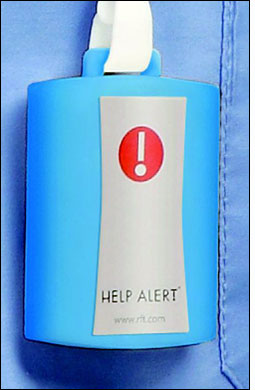Jun 10, 2010Teachers at Shorewood High School, near Milwaukee, are making use of an added security layer in their classrooms and hallways, thanks to a system known as Help Alert, provided by RF Technologies. Staff members are issued RFID-enabled pendants worn on lanyards or carried in pockets, and can call for help merely by pressing a button on one of the devices. Since the system was installed, the administration reports, it has been used in one emergency event, alerting the school's assistant principal when a fight between two students erupted in a class room, and enabling him to respond in time to break up the altercation.
The Help Alert system operates over either an existing Wi-Fi network, or a mesh network of Help Alert readers (which the company calls "routers") complying with the ZigBee IEEE 802.15.2 protocol, according to David Bussa, the global solutions director of RF Technologies' Pinpoint division, which includes the Help Alert system. Because Shorewood High School has no Wi-Fi system in place, it selected the ZigBee-based option. The school completed a beta test of the system in several buildings, and is now awaiting a federal grant to fund the installation's expansion.

Built in various stages between 1924 and 1932, the high school encompasses a 790,000-square-foot campus that includes five buildings, each three and a half stories in height, with walls up to 3 feet thick, and floors and stairs made of marble. "This was a great choice for a testing location," says Windham Gary, RF Technologies' VP of engineering. "We couldn't have found a more challenging facility" to test transmission from tags to readers, and from readers to the gateway that sends the data to the district's back-end system. The school wanted to have coverage not only in its three classroom buildings, but also in the open areas between those buildings in which students and employees walk while passing from one classroom to another. Administrators wanted teachers to be able to send an alert if a medical emergency, a fight between students, the appearance of an unauthorized stranger or some other incident occurred in the open areas.
"We are fortunate to have had very few emergency incidents," says Tim Kenney, the school district's director of safety and the high school's former assistant principal. However, he adds, the nature of the campus makes a wireless system a good idea, since there is no way, with the open campus, to lock down the entire school in the event of an emergency. The classrooms include phones that teachers can use to reach the front office during an emergency, but that requires more time to place the call, and the phone lines may be busy, which often occurs when several staff members in the office make calls simultaneously. For that reason, Kenney says he "thought this system would be very appropriate for Shorewood High School."
The system has been installed in three of the buildings, with plans to eventually deploy the technology in all five. In late 2008, RF Technologies began the process of installing and testing the system to ensure the routers were reading the tags and forwarding data properly to gateways and, ultimately, to the back-end software. Additional power outlets in the halls had to be installed in order to accommodate some of the readers, which delayed the RFID system's installation. Initially, a handful of employees carried the tags and tested them throughout the buildings as the system was being installed. The wireless tracking system went live in February of this year, with a total of 90 routers covering 180,000 square feet of the campus.
"In the case of schools, the granularity you are looking for is room accuracy," Gary says. Administrators need to know in which room an alert button was pressed, rather than where in that room the tag was located. The software displays a map of the school, and an icon indicates the tag's location on a computer sitting on the assistant principal's desk, and also issues the alert to the pagers or cell phones of select staff members, with a message indicating in which room an emergency is occurring, in addition to who triggered that alert.
The system was tested several times before going live, Kenney says. "We found my buzzer responded seven seconds after the button was pushed [on a tag],"he states, noting that he was then able to respond in a matter of seconds because "the campus is not that large, and I can run fast."
At present, Shorewood High School is in the process of securing funding for the installation of the system in the campus' two remaining buildings—the gymnasium area, and a recreational center also used by the public outside of school hours. The administration also hopes to install readers in the open areas between the buildings, to cover the entire campus outdoors, as well as in ball fields. Once that installation is complete, the district intends to finalize funding per the terms of the grant that it is securing to deploy the system at its middle school and two elementary schools.
In addition, RF Technologies is installing the Wi-Fi version of Help Alert at an elementary school in Wisconsin's Janesville School District, to leverage the school's existing Wi-Fi system. In this case, Gary says, the RF Technologies software is Internet-based, so information can be accessed remotely. What's more, the system can send messages to the district's security team, and to the local police station. The tags can be set to check in at preset intervals as well—for example, every 30 seconds or every 24 hours.


